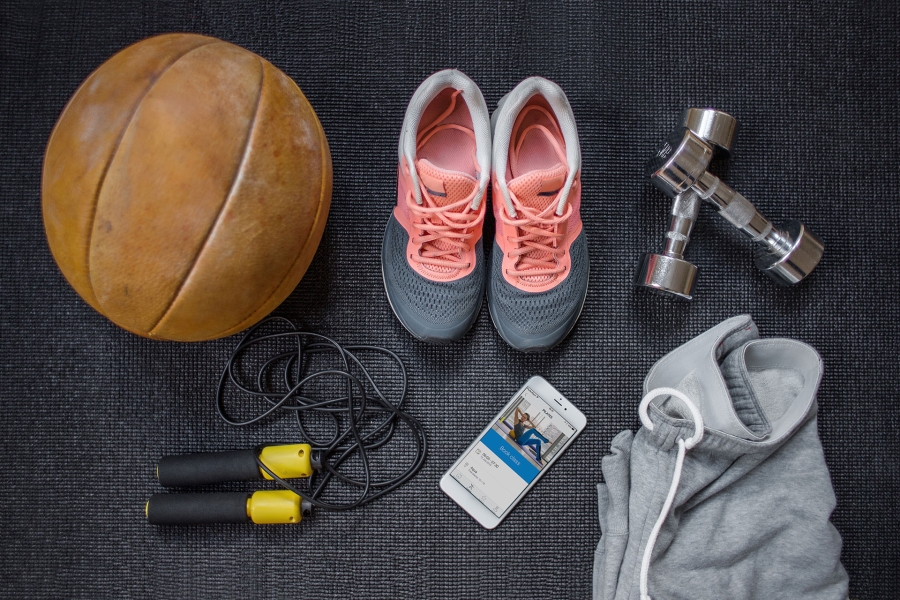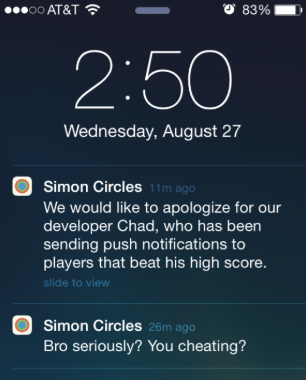
There are three main channels that fitness clubs use to connect with their members: email, SMS messages and push notifications.
Each has its own pros and cons, but when it comes to engaging your club members or getting them to take a specific action, push notifications are far and away the most converting channel.

Here we’ll highlight the circumstances in which push notifications should be used as a primary club marketing channel and how they can be used effectively to drive club member engagement.
Push Notifications as a Primary Marketing Channel
Every marketing channel has it’s benefits and drawbacks, and the 3 most widely used channels for gyms are no different.
While emails are the optimal channel for spreading knowledge and longer form content, they have lower open rates than push notifications. As Marketing Insider Group reports, emails for the Health & Fitness industry have a 22% open rate and a 2.4% click-through-rate.
SMS messages, while typically opened more often than push notifications, do not see the same kind of conversion rates as push notifications and are much more expensive.
Here you can see a breakdown of each channel and it’s benefits and drawbacks.

As you can see, push notifications do indeed have a few drawbacks as they:
- aren’t the best channel for dispensing long-form content
- are limited in terms of how much information they can share
- do not have as much room for personalization
However, these limitations pale in comparison to the benefits they bring when compared to the other channels for the same attributes listed.
For example, gyms have the unique advantage of using all three types of push notifications to engage with their members.
You can alert users to take actions like sign-up for classes or make payments. They can also be notified of events like promotions or when their friends sign-up for challenges with them.
Furthermore, you can remind them of upcoming commitments like classes or personal training sessions.
Open Rates
Given that people are on average on their phones for 4+ hours a day, it shouldn’t be any secret that SMS and push notifications have much higher open rates than emails.
Emails have the drawback of either going unopened and dying in an inbox or being moved to the spam folder, never to be seen again.
Furthermore, many open rate metrics for push notifications are extremely difficult to measure as push notifications can be fully read as banners, lock screen or alerts and thus are never opened.
So if you have a short message to send that needs to be seen, SMS messages and push notifications are the way to go.
Conversion Rates
It’s important to note that a conversion is anything that the sender of the message wants the recipient to do; whether that is, in the case of fitness management, to get the club member to renew their contract, sign-up for a challenge, submit a form, etc.
Push notifications have the direct advantages of creating deep links, which are links that not only take them to the app, but put them on the page that’s already linked into their account.
So if the goal is to get a gym member to sign-up for a challenge, then just by clicking the push notification they’ll be taken straight to the page where they can click the sign-up button.
When messages are targeted using client segmentation, the conversion rate for opened messages can be an astounding 54%!
All it takes are the right tools to use to segment your users and personalize your messaging.
Personalization
Every channel can be personalized; however, with the limited amount of space available for push notifications, you need to be quick and to the point when using user attributes or events to personalize the message.
For example:

With PerfectGym’s automation center you can personalize SMS messages, emails and push notifications to increase your conversion and open rates.
When a user clicks on the message as a push notification, they can be taken directly to the desired page to complete the request action.
Just make sure you stay under 100 characters when crafting messages for iOS users and under 90 when creating them for Android users, otherwise your message will cut off, depending on where it’s displayed.
Length
A study conducted by Microsoft a few years ago revealed that the average human’s attention span is just 8 seconds. While this may or may not be true for some people, the reason isn’t that we just can’t focus; rather it’s that there are so many nuanced channels to get information from.
That’s why a multi-pronged approach for getting your information out there is important. Push notifications should be between 60-100 characters for iOS and Android so that you ensure it looks nice and tidy when it appears on your club members’ mobile device.
If you can optimize the heart of the message in that small space, you can send the more detailed version via email, without constraints on how long it needs to be.
Time to Open
As described above, people are constantly on their phones, which means that when a message is sent via SMS or push notifications, they will more often than not open it immediately.
The benefit is that if the message is just a simple reminder, then it has served its purpose in being sent and understood by the user.
Emails, however, can take up to a few hours to be opened after they are sent which limits the channel’s value for reminders or quick actions.
Engagement
Engagement usually means wanting your members to interact with your club whether it be online or in-person.
Thus, not only is each channel is reliant on clients opening the messages to properly engage with them, but if certain actions need to be taken in regard to the message, the engagement will be much higher with push notifications as more clients are likely to see it and take action. .
Push notifications have a reaction or click-through-rate of about 8% on average, with Android users 12% outperforming iOS users 4%
Costs
In terms of costs, SMS is the most expensive channel as mass messaging can cost a few dollars or even more depending on the size of the audience.
Email providers can charge a monthly fee and can limit the amount of emails you send.
Push notifications are the most cost-effective channel as they are virtually unlimited in the amount of messages you can send.
Knowledge Shared
When you need to send directions, educational materials or how-to-content, emails are by far the best channel.
You can of course send short descriptions of the content with links for users to read more, but in this case it’s best to save them an extra step and include it in the email content.
Reach
As noted earlier, your reach is only as good as your open rates. If people don’t open your message, they never see it.
That’s why push notifications and SMS messages are the most optimal as they are likely to be seen more than standard emails.
Push notifications even more so as they can appear as banners, in feeds, badge app icons or even as sound notifications that will alert you to the notification.
However, the one drawback with push notifications is that users frequently opt-out of them, sometimes as much as 60% of app users depending on the industry.
That’s why it’s important to stick to good practices when using push notifications to keep your opt-out rates low, which we’ll get to in a bit.
Best Practices for Push Notifications
Whatever the reason, when creating your push notifications, there a few practices you should follow to ensure that you’re:
- reaching the right people
- formatting your messages correctly
- sending them at the right time
- using data to target your members
- supplementing them correctly with your email campaigns
- using the channel for the right circumstances
By following these guidelines, you’ll be able to maximize the efficiency of push notifications for your fitness business and keep your members happy.
Composing Your Push Notifications
As the marketing channel that allows the least amount of characters among the channels discussed in this article, push notifications should be short, to the point and of course be error free.
Remember, 60-90 character limit for Android and 120 for iOS. Also, it’s a good idea to front-load your notification with the most important information so that users can understand it even at a glance.
As you well know, sometimes a glance is all you get, so remember to proofread your messages so your club members aren’t receiving correspondence with errors.
Also, if you can, try and find a voice for your gym, a way of speaking that captures your brand. Maybe you want to be fun, professional or a mixture of both such as the company below.

Target Your Audience
Almost as important as what’s in the message is who it’s sent to.
For fitness clubs, you can segment your users into groups based on:
- what classes they attend
- what trainers they work with
- what challenges or competitions they participate in
- their goals
- gender
- age-group
- purchase history
There are numerous ways to segment your members and using these segments to send targeted and personalized messages can increase your conversion rates significantly.
For example, if you’re offering new zumba classes at different times, instead of sending a club-wide message, you can simply segment for users that have taken a zumba class previously.
Just be sure to keep a digital footprint of your client’s actions (attendance, signups, etc.) and intentions (goals, bookings, etc.) so that you have the information at your disposal to use for targeting your club members in your push notification marketing.
Supplement Push Notifications with Emails
While email marketing may have different purposes than push notifications, they nonetheless should be used together to achieve the same goal.
For example, you can send emails to confirm that a class has just been booked and push notifications to remind your gym members that the class will begin in a an hour.
The same can be done with contract extensions, both of which can contain a link to renew their contract either on your website or on your mobile app.
However you choose to deploy them, ensure that you are using both channels effectively to achieve the same goal.
Message Timing
There’s always a right time and a wrong time to send a message. Asking for a contract renewal the day before it expires or sending a spin class reminder 15 minutes before it starts probably aren’t the best of ideas.
Always make sure you give your clients ample enough time to react to what you’re asking them to do or reminding them about.
If you’re sending out push notifications about upcoming promotions, make sure you let them know about the promotion a few days or weeks in advance. The same goes for membership extensions.
Conclusion
Push notifications can be an effective tool in your fitness marketing arsenal if they are used correctly.
While email and SMS messages have their uses, push notifications have the advantage of being opened and consumed on a mobile device, which is where the majority of your members spend a lot of their time.
Ensure that if you’re club has a mobile app, you’re not only using it as a marketing channel, but you’re using it to keep your members engaged and informed.